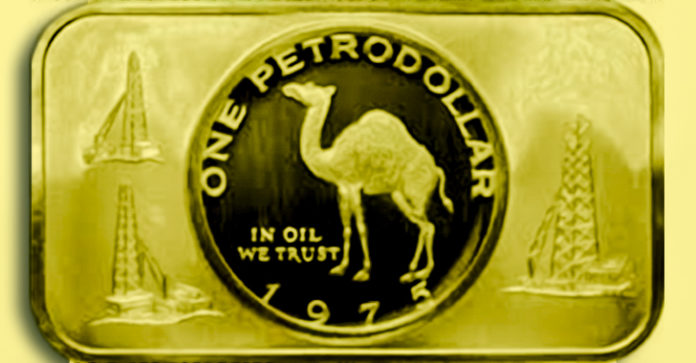
(ZHE) For decades, the story of Saudi Arabia recycling petrodollars, i.e., funding the US deficit by buying US Treasuries with proceeds of its crude oil sales (mostly to the US), while the US sweetened the deal by providing the Saudis with military equipment and supplies, remained entirely in the conspiracy realm, with no confirmation or official statement from the US Treasury department.
Now, that particular “theory” becomes the latest fact, thanks to a fascinating story by Bloomberg which gives the background and details of secret meeting between then-US Treasury secretary William Simon and his deputy, Gerry Parsky, and members of the Saudi ruling elite, and lays out the history of how the petrodollar was born.
Here is the background:
“It was July 1974. A steady predawn drizzle had given way to overcast skies when William Simon, newly appointed U.S. Treasury secretary, and his deputy, Gerry Parsky, stepped onto an 8 a.m. flight from Andrews Air Force Base. On board, the mood was tense. That year, the oil crisis had hit home. An embargo by OPEC’s Arab nations—payback for U.S. military aid to the Israelis during the Yom Kippur War—quadrupled oil prices. Inflation soared, the stock market crashed, and the U.S. economy was in a tailspin.
“Officially, Simon’s two-week trip was billed as a tour of economic diplomacy across Europe and the Middle East, full of the customary meet-and-greets and evening banquets. But the real mission, kept in strict confidence within President Richard Nixon’s inner circle, would take place during a four-day layover in the coastal city of Jeddah, Saudi Arabia.
“The goal: neutralize crude oil as an economic weapon and find a way to persuade a hostile kingdom to finance America’s widening deficit with its newfound petrodollar wealth. And according to Parsky, Nixon made clear there was simply no coming back empty-handed. Failure would not only jeopardize America’s financial health but could also give the Soviet Union an opening to make further inroads into the Arab world.
“It ‘wasn’t a question of whether it could be done or it couldn’t be done,’ said Parsky, 73, one of the few officials with Simon during the Saudi talks.”
As noted above, the framework of the required deal was simple: the U.S. would buy oil from Saudi Arabia and provide the kingdom military aid and equipment. In return, the Saudis would plow billions of their petrodollar revenue back into Treasuries and finance America’s spending.
The man leading the US negotiation, US Treasury Secretary William Simon, had just done a stint as Nixon’s energy czar, and “seemed ill-suited for such delicate diplomacy. Before being tapped by Nixon, the chain-smoking New Jersey native ran the vaunted Treasuries desk at Salomon Brothers. To career bureaucrats, the brash Wall Street bond trader—who once compared himself to Genghis Khan—had a temper and an outsize ego that was painfully out of step in Washington. Just a week before setting foot in Saudi Arabia, Simon publicly lambasted the Shah of Iran, a close regional ally at the time, calling him a “nut.”
“But Simon, better than anyone else, understood the appeal of U.S. government debt and how to sell the Saudis on the idea that America was the safest place to park their petrodollars. With that knowledge, the administration hatched an unprecedented do-or-die plan that would come to influence just about every aspect of U.S.-Saudi relations over the next four decades (Simon died in 2000 at the age of 72).”
In the beginning it wasn’t easy: “it took several discreet follow-up meetings to iron out all the details, Parsky said.”
But at the end of months of negotiations, Bloomberg writes, there remained one small, yet crucial, catch: King Faisal bin Abdulaziz Al Saud demanded the country’s Treasury purchases stay “strictly secret,” according to a diplomatic cable obtained by Bloomberg from the National Archives database.
The secret remains… until May 16 when the US Treasury for the first time ever revealed the full extent of Saudi TSY holdings.
Bloomberg adds that with a handful of Treasury and Federal Reserve officials, the secret was kept for more than four decades—until now. “In response to a Freedom-of-Information-Act request submitted by Bloomberg News, the Treasury broke out Saudi Arabia’s holdings for the first time this month after ‘concluding that it was consistent with transparency and the law to disclose the data,’ according to spokeswoman Whitney Smith. The $117 billion trove makes the kingdom one of America’s largest foreign creditors.”
The TIC data released later that day confirmed the FOIA response.
To be sure, as we commented in mid-May, it is very likely that the Treasury report is incomplete, and that the Saudis also own hundreds of billions in Treasurys held in custody with offshore trading centers such as Euroclear. After all, the current tally represents just 20 percent of its $587 billion of foreign reserves, well below the two-thirds that central banks typically keep in dollar assets
What’s more, the commitment to the decades-old policy of “interdependence” between the U.S. and Saudi Arabia, which arose from Simon’s debt deal and ultimately bound together two nations that share few common values, is showing signs of fraying. America has taken tentative steps toward a rapprochement with Iran, highlighted by President Barack Obama’s landmark nuclear deal last year. The U.S. shale boom has also made America far less reliant on Saudi oil.
Needless to say, the real total notional amount of Saudi holdings will eventually become known, especially if the middle-eastern nation follows through with its threat of liquidating some or all of them. What is more notable, however, is that with the first disclosure of this data since the birth of the petrodollar, something appears to have changed:
“What’s more, the commitment to the decades-old policy of ‘interdependence’ between the U.S. and Saudi Arabia, which arose from Simon’s debt deal and ultimately bound together two nations that share few common values, is showing signs of fraying. America has taken tentative steps toward a rapprochement with Iran, highlighted by President Barack Obama’s landmark nuclear deal last year. The U.S. shale boom has also made America far less reliant on Saudi oil.
“’Buying bonds and all that was a strategy to recycle petrodollars back into the U.S.,’ said David Ottaway, a Middle East fellow at the Woodrow Wilson International Center in Washington. But politically, ‘it’s always been an ambiguous, constrained relationship.’”
One thing that certainly changed is that in a world where central banks are ravenously buying up each others’ (and their own) debt, the need for Petrodollar recyclers such as Saudi Arabia is no longer there. But that was not always the case:
“[B]ack in 1974, forging that relationship (and the secrecy that it required) was a no-brainer, according to Parsky, who is now chairman of Aurora Capital Group, a private equity firm in Los Angeles. Many of America’s allies, including the U.K. and Japan, were also deeply dependent on Saudi oil and quietly vying to get the kingdom to reinvest money back into their own economies.
“‘Everyone—in the U.S., France, Britain, Japan—was trying to get their fingers in the Saudis’ pockets,’ said Gordon S. Brown, an economic officer with the State Department at the U.S. embassy in Riyadh from 1976 to 1978. For the Saudis, politics played a big role in their insistence that all Treasury investments remain anonymous.”
America’s reliance on Saudi Arabia to fund its deficit – and obtain a cheap price for oil – meant that the kingdom would be granted Platinum status in every form of interaction with the US.
“Tensions still flared 10 months after the Yom Kippur War, and throughout the Arab world, there was plenty of animosity toward the U.S. for its support of Israel. According to diplomatic cables, King Faisal’s biggest fear was the perception Saudi oil money would, ‘directly or indirectly,’ end up in the hands of its biggest enemy in the form of additional U.S. assistance.
“Treasury officials solved the dilemma by letting the Saudis in through the back door. In the first of many special arrangements, the U.S. allowed Saudi Arabia to bypass the normal competitive bidding process for buying Treasuries by creating ‘add-ons.’ Those sales, which were excluded from the official auction totals, hid all traces of Saudi Arabia’s presence in the U.S. government debt market.
“’When I arrived at the embassy, I was told by people there that this is Treasury’s business,’ Brown said. ‘It was all handled very privately.’”
* * *
“Another exception was carved out for Saudi Arabia when the Treasury started releasing monthly country-by-country breakdowns of U.S. debt ownership. Instead of disclosing Saudi Arabia’s holdings, the Treasury grouped them with 14 other nations, such as Kuwait, the United Arab Emirates and Nigeria, under the generic heading ‘oil exporters’—a practice that continued for 41 years.”
Meanwhile, Saudi Arabia continued buying: by 1977, Saudi Arabia had accumulated about 20 percent of all Treasuries held abroad, according to The Hidden Hand of American Hegemony: Petrodollar Recycling and International Markets by Columbia University’s David Spiro.
The deal led to assorted headaches: “an internal memo, dated October 1976, detailed how the U.S. inadvertently raised far more than the $800 million it intended to borrow at auction. At the time, two unidentified central banks used add-ons to buy an additional $400 million of Treasuries each. In the end, one bank was awarded its portion a day late to keep the U.S. from exceeding the limit.
“Most of these maneuvers and hiccups were swept under the rug, and top Treasury officials went to great lengths to preserve the status quo and protect their Middle East allies as scrutiny of America’s biggest creditors increased.
“Over the years, the Treasury repeatedly turned to the International Investment and Trade in Services Survey Act of 1976—which shields individuals in countries where Treasuries are narrowly held—as its first line of defense.
“The strategy continued even after the Government Accountability Office, in a 1979 investigation, found “no statistical or legal basis” for the blackout. The GAO didn’t have power to force the Treasury to turn over the data, but it concluded the U.S. “made special commitments of financial confidentiality to Saudi Arabia” and possibly other OPEC nations.
“Simon, who had by then returned to Wall Street, acknowledged in congressional testimony that “regional reporting was the only way in which Saudi Arabia would agree” to invest using the add-on system.”
Ultimately, Saudi dominance in the US Treasury market meant they were untouchable. “It was clear the Treasury people weren’t going to cooperate at all,” said Stephen McSpadden, a former counsel to the congressional subcommittee that pressed for the GAO inquiries. “I’d been at the subcommittee for 17 years, and I’d never seen anything like that.”
Today, Parsky says the secret arrangement with the Saudis should have been dismantled years ago and was surprised the Treasury kept it in place for so long. But even so, he has no regrets. Doing the deal “was a positive for America”, he says cited by Bloomberg.
And with that the story of how the Petrodollar was born is now public information, something which Saudi Arabia may not be too happy with. For the sake of the US, it better have its ducks in order because the release of this story simply means that the US Treasury is confident it will no longer have a strategic need for its long-time Saudi partner. The Fed, which has implicitly stepped into the Saudi role, better not disappoint.
This article (The Fascinating Story Of How The Petrodollar Was Born And Lived In Secrecy For Over 40 Years) by Tyler Durden originally appeared on ZeroHedge.com and was used with permission.






